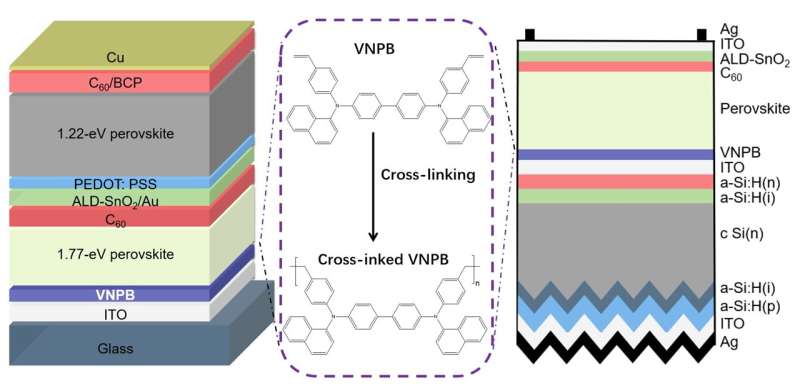Schematic of perovskite/perovskite and perovskite/silicon tandem solar cells. Credit: ©Science China Press
The power conversion efficiency (PCE) of single-junction perovskite solar cells (PSCs) has increased remarkably from 3.8% to 25.2% in just a decade. As the rapid development of PCE has been approaching the limit of its theoretical efficiency, fabricating tandem solar cells by combining subcells with different bandgaps offers an avenue to go beyond the Shockley-Queisser limits of single-junction solar cells.
The tandem devices utilize different parts of the solar spectra using subcells with different bandgaps to reduce the thermal loss of photo-generated carriers. Due to the tunable bandgap, high absorption coefficient and low fabrication cost, metal halide perovskites are promising candidates for tandem devices.
However, the efficiency of perovskite-based tandem solar cells is largely limited by wide-bandgap top-cells which typically possess a large open-circuit voltage (VOC) loss. The severe nonradiative charge recombination at the interface between perovskite and hole transport layer (HTL) is a key factor leading to the large VOC loss.
Recently, research group of Prof. Hairen Tan from Nanjing University has used the cross-linked organic small molecule VNPB as the HTL for wide-bandgap perovskite solar cells. A VOC increase of nearly 50 mV was successfully obtained for wide-bandgap solar cells with bandgaps of 1.6 eV, 1.7 eV and 1.8 eV. Compared with the control device using PTAA polymeric HTL, the perovskite films deposited on VNPB have larger grain size and better crystallinity. VNPB enables faster charge extraction and reduces defect density at the HTL/perovskite interface.
Density functional theory (DFT) calculation shows that the closer contact between VNPB and perovskite increases the defect formation energy and decreases the defect density, thus effectively reducing the non-radiative recombination of carriers. Finally, the PCEs of perovskite/perovskite and perovskite/silicon tandem solar cells using VNPB as HTL reach 24.9% and 25.4%, respectively.
This work shows that cross-linkable small molecules are promising for high-efficiency and cost-effective perovskite tandem photovoltaic devices.
More information: Yurui Wang et al, Cross-linked hole transport layers for high-efficiency perovskite tandem solar cells, Science China Chemistry (2021). DOI: 10.1007/s11426-021-1059-1
Provided by Science China Press
























